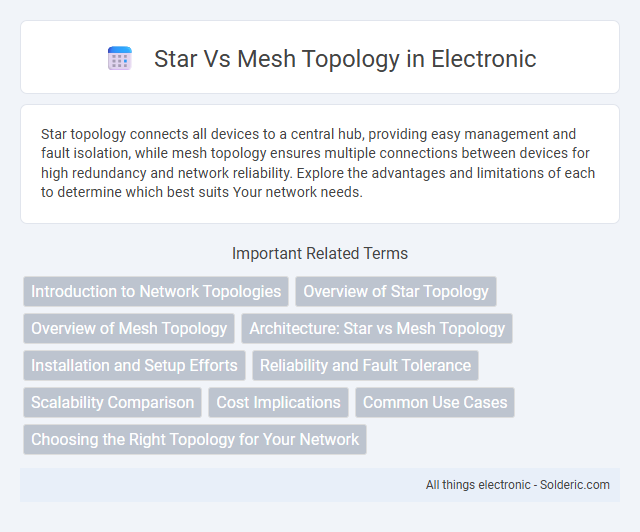Star topology connects all devices to a central hub, providing easy management and fault isolation, while mesh topology ensures multiple connections between devices for high redundancy and network reliability. Explore the advantages and limitations of each to determine which best suits Your network needs.
Comparison Table
| Feature | Star Topology | Mesh Topology |
|---|---|---|
| Network Structure | Devices connected to a central hub | Devices interconnected with multiple links |
| Reliability | Single point of failure at the hub | Highly reliable; multiple paths |
| Scalability | Easy to add devices via hub | Complex as each new device connects to all others |
| Cost | Lower initial cost; requires central hub | Higher cost due to extensive cabling |
| Setup Complexity | Simple configuration and setup | Complex configuration and maintenance |
| Performance | Dependent on central hub capacity | High performance; direct device communication |
| Use Case | Small to medium-sized networks | Mission-critical and large networks |
Introduction to Network Topologies
Network topologies define the arrangement of devices and communication paths within a network, with star and mesh as two common structures. In a star topology, devices connect to a central hub, ensuring simplified management and fault isolation, while a mesh topology links each device directly to multiple others, enhancing redundancy and reliability. Understanding these topologies helps you choose the optimal network design based on scalability, performance, and fault tolerance needs.
Overview of Star Topology
Star topology features a central hub or switch to which all nodes connect directly, ensuring efficient data transmission and easy network management. This configuration minimizes the risk of network failure since each device operates independently; if one link fails, others remain unaffected. You benefit from simplified troubleshooting and scalable expansion options, making it ideal for many modern network environments.
Overview of Mesh Topology
Mesh topology features a network design where each device connects directly to multiple other devices, creating a web-like structure that enhances redundancy and fault tolerance. This topology offers high reliability by allowing multiple data paths, reducing the risk of network failure due to a single point of connection loss. Commonly used in mission-critical networks and wireless setups like ad hoc networks, mesh topology ensures robust communication through dynamic routing and self-healing capabilities.
Architecture: Star vs Mesh Topology
Star topology features a central hub or switch connecting all devices individually, enabling simplified management and isolation of faults. Mesh topology interconnects every device directly with multiple others, providing high redundancy and robust network reliability through multiple communication paths. The choice between star and mesh topology impacts network scalability, fault tolerance, and complexity of cabling infrastructure.
Installation and Setup Efforts
Star topology requires more cables and central hardware, increasing installation complexity but offering easier fault isolation. Mesh topology demands extensive cabling and configuration due to every device connecting to multiple others, resulting in higher setup efforts and maintenance challenges. Your choice depends on balancing initial installation resources against network reliability and scalability needs.
Reliability and Fault Tolerance
Star topology offers high reliability by isolating each device via a central hub, ensuring a single node failure doesn't affect the entire network. Mesh topology provides superior fault tolerance through multiple redundant paths, allowing continuous data transmission even if several links fail. Your choice depends on whether centralized control or maximum fault resilience is a priority for your network infrastructure.
Scalability Comparison
Star topology offers higher scalability compared to mesh topology due to its centralized structure, allowing easy addition of new nodes without reconfiguring the entire network. Mesh topology, while providing robust redundancy and reliability, becomes exponentially complex and costly as more nodes are added, limiting its scalability in large networks. Enterprises often prefer star topology for scalable LAN environments, whereas mesh is favored in critical infrastructures requiring fault tolerance.
Cost Implications
Star topology incurs higher initial costs due to the need for a central hub or switch, which acts as a single point of failure but simplifies network management. Mesh topology, by contrast, demands significantly more investment in cabling and network interfaces because each device connects directly to multiple others, enhancing redundancy and reliability. The extensive hardware and installation expenses make mesh topology more costly for large-scale deployments compared to the relatively affordable and scalable star configuration.
Common Use Cases
Star topology is commonly used in home networks, office LANs, and data centers due to its centralized management and ease of troubleshooting. Mesh topology is ideal for mission-critical applications like military communications, large-scale wireless networks, and IoT systems because of its high redundancy and fault tolerance. Both topologies enhance network reliability but serve distinct operational needs based on scalability and cost considerations.
Choosing the Right Topology for Your Network
Choosing the right topology for your network depends on factors like scalability, fault tolerance, and performance requirements. Star topology offers centralized management and ease of troubleshooting by connecting all nodes to a central hub, ideal for small to medium-sized networks with moderate traffic. Mesh topology provides high redundancy and reliability with direct connections between nodes, making it suitable for mission-critical environments requiring robust fault tolerance and minimal downtime.
Star vs Mesh topology Infographic

 solderic.com
solderic.com